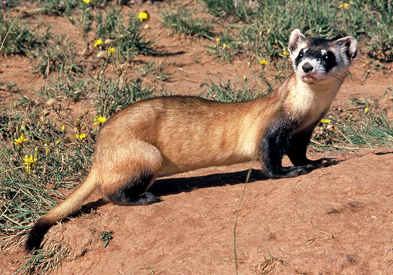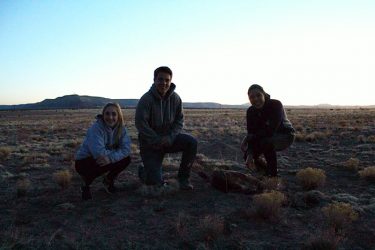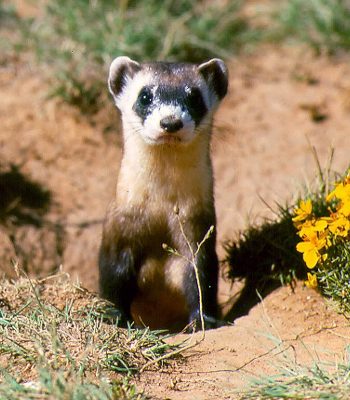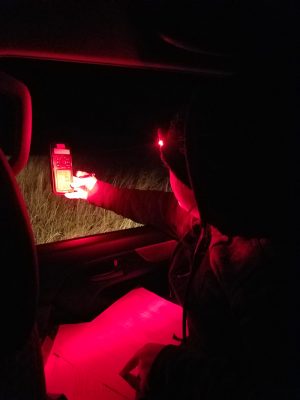
By Lana Sweeten-Shults
GCU News Bureau
It’s after midnight in Arizona’s Aubrey Valley, stretching for some 35 miles northwest of Seligman, its plains and grasslands framed in part by the majestic Aubrey Cliffs.
In just a few hours, with the daylight dripping over those cliffs, visitors to the valley might spot a red-tailed hawk, prairie falcon or American kestrel; this expanse of land, after all, is home to 16 raptor species.
But Adrienne Crawford, professor of biology, ecology and environmental science in Grand Canyon University’s College of Science, Engineering and Technology, and her small cadre of students haven’t nestled here for the night for the raptor species.

“We’re looking for two green eyes to look back at us,” said Crawford.
Not that many people actually WANT to see two glowing green eyes peering back at them at midnight.
But for this GCU team, and about 60 other volunteers, spying those two green eyes is a beautiful thing.
It was in April that the team made its way to the Aubrey Valley to help out in the black-footed ferret count, a four-times-a-year event, with two counts in the fall (usually in September and October) and two in the spring (around March and April).
The endangered species – scientific species name: Mustela nigripes -- was declared extinct in 1979, until a few dozen were discovered in Wyoming in 1981. Captive breeding facilities, such as the Phoenix Zoo, stepped in to increase those numbers in captivity.
Even still, the ferrets have existed on the brink for the past few decades.
It was in 1991 that the U.S. Fish and Wildlife Service launched a captive breeding program to reintroduce the ferrets into eight Western states and Mexico.
The Arizona Game and Fish Department began its black-footed ferret reintroduction program in the Aubrey Valley in 1996.
Those efforts, Crawford said, started with captive breeding and releasing, though now the focus is on releasing pregnant females into the wild so the pups aren't born in captivity.
“The biggest concern with any reintroduction is when they’re captive-bred, having success in the wild. Some of the natural instincts don’t kick in. They’ve been more successful with releasing the pregnant females.”
In the 22 years since the program began, the population of reintroduced ferrets has plummeted.
“There hasn’t been as much success as they would like,” Crawford said.

In 2012, Arizona Game and Fish Black-footed Ferret Program Supervisor Jennifer Cordova said 123 black-footed ferrets were trapped and documented. Compare that to last year, when 17 were captured – nine at one Aubrey Valley site and another eight at a different site.
“So they’re still hanging in there, just not in the numbers that we are used to,” Cordova said.
Those dismal numbers are a far cry from the excitement environmental scientists and volunteers felt when they discovered the first wild-born black-footed ferret kits in 2001.
Cordova said field experts don’t know why those numbers, so promising in the beginning, have taken such a big dive over the last few years.
“We haven’t picked up plague or distemper,” she said. “… It could be an increase in predation. It could be they’re dispersing farther (away from the Aubrey Valley). It could be the drought, too.”
It’s why the latest counts have been so vital – and why GCU’s environmental science department has wanted to lend a hand. They’ve participated in the black-footed ferret count twice, in November 2017 and in April 2018, and Crawford is hoping to take students to the Aubrey Valley for the count at least once a semester.
She and her GCU students, when they get the email for the ferret spotlight count, head to the valley where they spend 10 hours on count day, from 8 p.m. to 6 a.m., trying to spot and capture these nocturnal animals using a technique called spotlighting.
“They’re pretty solitary animals, so they only really socialize during breeding times,” Crawford said.
The team during the most recent count in April headed out to an assigned quadrant in the roughly 50,000-acre core reintroduction area. They carried two high-powered spotlights with them and stationed one volunteer on the left and another on the right of their observation area.
The team will mark sightings. If they know what hole the ferret disappeared into, they will place a flag on that spot (the black-footed ferret lives in holes dug by prairie dogs). One of the goals is to count the number of active burrows.
“We’ll also mark any other important information, such as coyotes, porcupines, skunks and burrowing owls – things like that that might be in the area,” Crawford said.
If volunteers do see which hole the ferret used to escape, they’ll set up a trap and will plug in any surrounding holes so the ferret has only one route out.
Captured ferrets are then transported back to the field station for a full workup. It’s where they receive vaccinations for the sylvatic plague and canine distemper, diseases to which they are susceptible. The wild-born ferrets also are tagged before being re-released.
While last year saw nine ferrets captured at that one Aubrey Valley site, this year that number dropped even more. Volunteers were able to capture seven ferrets – six were new captures and one was a recapture.

The species, native to New Mexico, Arizona, Wyoming and parts of Montana, has an interesting history interwoven with that of the prairie dog, which is its main food source. Crawford said prairie dogs are considered a “keystone species,” meaning they play a critical role in the environment, influencing other species in the ecosystem.
“You remove them then you get the collapse of other species, and the black-footed ferret is a good example of that,” she added.
Up to 91 percent of the ferret’s diet is the prairie dog, andAubrey Valley's prairie dog population is why it was chosen as a site to reintroduce the species. Their burrowing holes become habitats for the ferrets, burrowing owls and different types of snakes.
When farmers and ranchers started to decimate the prairie dog population, the black-footed ferret population dropped significantly.
“Farmers and ranchers aren’t huge fans of holes in their prairie lands or in their ranch lands and so there was a huge initiative, basically, to eradicate them from the grasslands prior to 1970,” Crawford said.
Add to that the susceptibility of the animals to diseases such as plague and canine distemper and the loss of their habitat, and their existence has become precarious.
Crawford said it’s important for GCU students, particularly those in the environmental sciences, to be involved in projects like the black-footed ferret count. They get to see concepts in the classroom being applied and get hands-on learning experience for field biology techniques.
“What’s nice for students is, in several of the courses I teach, we talk about endangered species and what’s going extinct. Here’s an animal that was considered extinct 50 years ago and has been absent from Arizona for almost 60 years, and we have this opportunity, as stewards of the environment, and with our Christian worldview, we have opportunities as stewards to contribute to this effort and monitor populations.”
Arizona Game and Fish’s Cordova said the department couldn’t do the work it does without the help of its volunteers.
“It’s just two people on the program. There’s no way to cover that ground (the 50,000 acres that’s part of the reintroduction program),” she said. And with the drastic decline in the past few years, “That’s why it’s doubly important to have our volunteers.”
The next black-footed ferret count is coming up in September, with the department calling out for volunteers beginning in July.
GCU’s team did not see what they were looking for on this trip – those two green eyes staring back at them.
“Even though we didn’t personally catch a ferret, the students were saying, ‘This is so cool' It’s nothing fancy, but it’s still that idea that you're doing something with purpose.”
You can reach GCU senior writer Lana Sweeten-Shults at [email protected] or at 602-639-7901.















